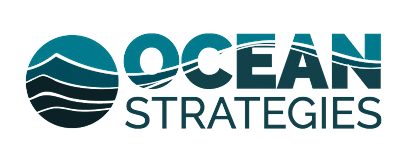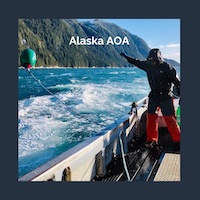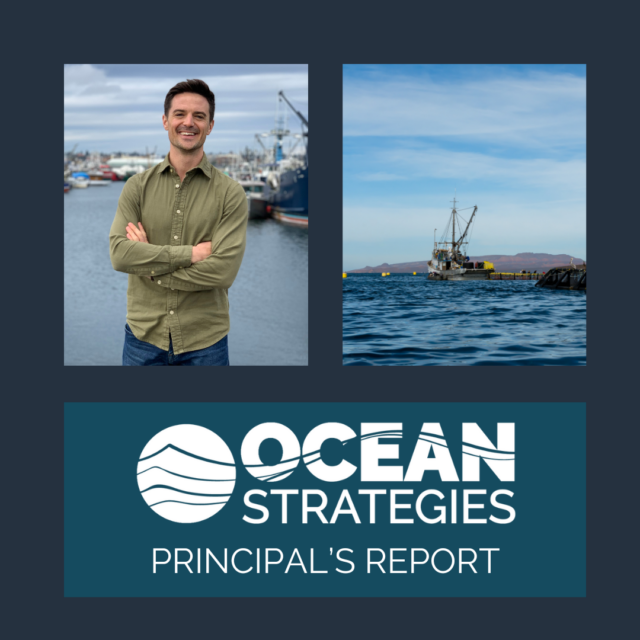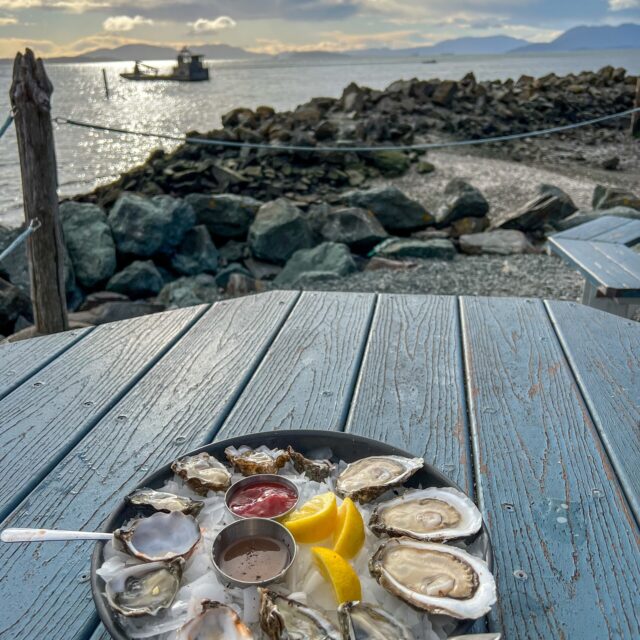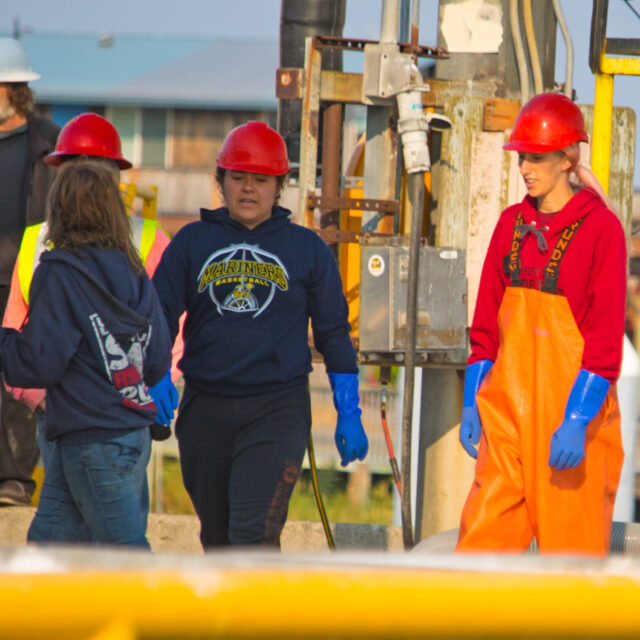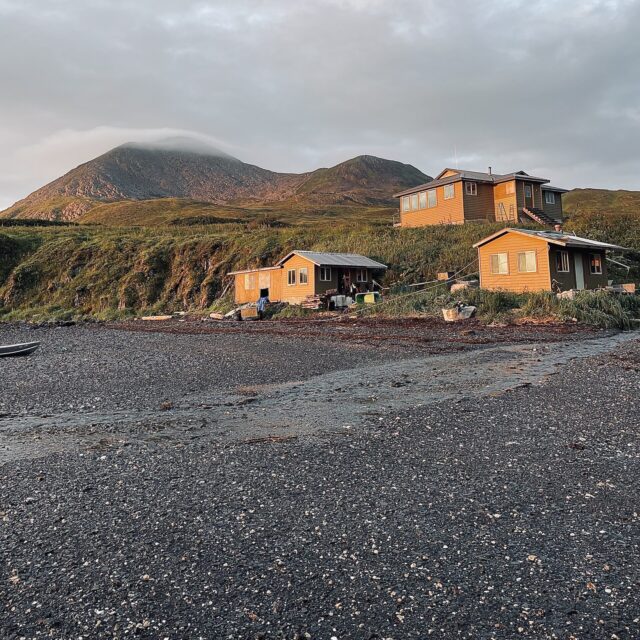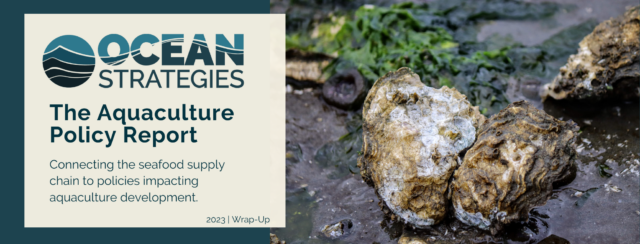
Ocean Strategies is a public affairs firm specializing in seafood, fisheries and marine resources. The Aquaculture Policy Report provides timely policy and industry updates connecting sectors across the seafood supply chain to aquaculture policy development. Sign up here.
America’s policy makers and industry experts are charting a course for the future of U.S. aquaculture, and we’re here to help track what affects you and your business. Supply chains and seafood communities nationwide have a stake in where and how aquaculture development happens and how we set standards and priorities. Keep reading for spotlights and opportunities.
Included In The Report
- Comments Open: Next Steps for Alaska’s AOA Process
- Principal’s Report
- Federal Policy Updates
- SEAfood Act
- SEAS Act
- SHELLS Act
- AQUAA Act
- Coastal Seaweed Farm Act
- USDA Agriculture Census
- Agriculture Spotlights: Coast-to-Coast
- Events & Opportunities
Comments Open: Next Steps for Alaska’s AOA Process
NOAA’s Office
of Aquaculture hosted two webinars in November and opened a 60-day comment period at the end of October. Visit the agency’s Alaska Summary Page to request more information on the process, view the webinar slide deck, or submit your comments.
According to NOAA Fisheries, Alaska received more letters of support than any other region during a 60-day public comment period in 2020.
In Alaska, the effort to identify AOAs will be focused in state waters. In accordance with Alaska state law that prohibits finfish farming, NOAA will only consider invertebrate (e.g., shellfish, sea cucumber, etc.) and seaweed production, which is referred to as “mariculture” in state statute and practice.
NOAA will use mapping tools, scientific advancements, and Indigenous Knowledge to incorporate key environmental, economic, social, and cultural considerations (for example, existing fisheries, protected areas, subsistence needs) and public comment into the process to identify areas that may support sustainable aquaculture development.
The identification of AOAs is strictly a planning process. While identifying AOAs can help applicants with site selection and environmental analysis, the process does not result in preapproval for any location. Applicants for aquaculture operations in identified AOAs will have to go through established state and federal permitting processes.
The mission behind NOAA’s AOA process is to open the door to aquaculture investment that complements wild-capture fisheries, provides ecosystem services (that is, benefits to marine habitats), minimizes environmental impacts, and is compatible with other marine industries and recreation. Aquaculture should also boost development of our nation’s shoreside, processing and distribution infrastructure for domestic seafood production.
Alaska is the third region where NOAA is pursuing the identification of Aquaculture Opportunity Areas, following Southern California and the Gulf of Mexico.
What are AOAs?
The Aquaculture Opportunity Area process defines geographic areas as environmentally, socially, and economically appropriate to support multiple commercial aquaculture operations. AOAs are designated only after being evaluated through both spatial analysis and National Environmental Policy Act review.
The size and location for AOAs will be determined through spatial analysis, Indigenous Knowledge, and public engagement in order to identify areas that are appropriate for commercial aquaculture.
This is a multi-year process in which NOAA and the state of Alaska will work to identify locations in state waters to help advance sustainable aquaculture – also referred to in Alaska as mariculture — that is part of a sustainable ecosystem.
For more information on the Why behind the AOA designation process, visit the Office of Aquaculture’s National AOA page or download the National AOA Fact Sheet.
From the desk of Principal Brett Veerhusen: Aquaculture Insights from California
It was a tough sell leaving Seattle for sunny San Diego in November. But the California Aquaculture Siting and Development Workshop, presented by National Sea Grant and NCCOS, called me south. I’m glad I went because I was the only commercial fisherman in attendance (not surprising given the Pacific Council was also meeting). ‘Tis the [meeting] season.
Many commercial fishing leaders served on the workshop’s advisory board and shaped a highly informative day. Did you know that Californians consume 25% of the seafood eaten in America? They also eat about 60% of the FDA’s recommended seafood portions, a higher rate than most other states, but still room for growth. It’s no wonder that given California’s outsized role in seafood consumption there is heightened interest in growing more locally.
Ocean Strategies is working in California after receiving a grant from Sea Pact to improve coordination and communication between aquaculture industries and California’s commercial fishing community. I’m a fisherman, but I’m not from California. So my first step is to listen, ask questions and try to understand the landscape. Here’s what stood out to me:
-
Fishermen are stretched thin. Offshore wind development, whale concerns, urgent management issues like crashing salmon populations and loss of working waterfronts are eating away at precious advocacy capacity. Aquaculture isn’t rising to the top, and aquaculturists and regulators need to go the extra mile with outreach and education. It’ll save a lot of headache in the long run. (If you need help, please let us know!)
-
Whether it’s environmental concerns, water quality impacting human health, coastal development or NIMBYism, navigating California’s aquaculture regulations is tough. That’s why the Port of San Diego is completing pre-development work to support aquaculture opportunities within San Diego Bay. The Humboldt Bay Mariculture Pre-Permitted Project already finalized a similar initiative. Localized, stakeholder-driven planning on siting and best practices is a critical step for safe, successful development that works with and comes from the community.
-
Ocean Rainforest is expanding its seaweed operations from the Faroe Islands to Santa Barbara and hopes to have seed planted in 2024 for its pilot offshore farm. The company’s team took great lengths in outreach to the fishing community.
-
Sea Grant is looking to gather and provide feedback to NCCOS on different spatial planning tools like the Coastal Aquaculture Planning Portal. Attend an upcoming workshop or connect with your local Sea Grant office.
Heads up that NOAA is slated to release its draft PEIS in summer 2024 to identify one or more Aquaculture Opportunity Area(s) in Southern California.
Couldn’t make it to San Diego but want to participate? Sea Grant is hosting another virtual workshop on Monday, January 22, 2024 — register here.
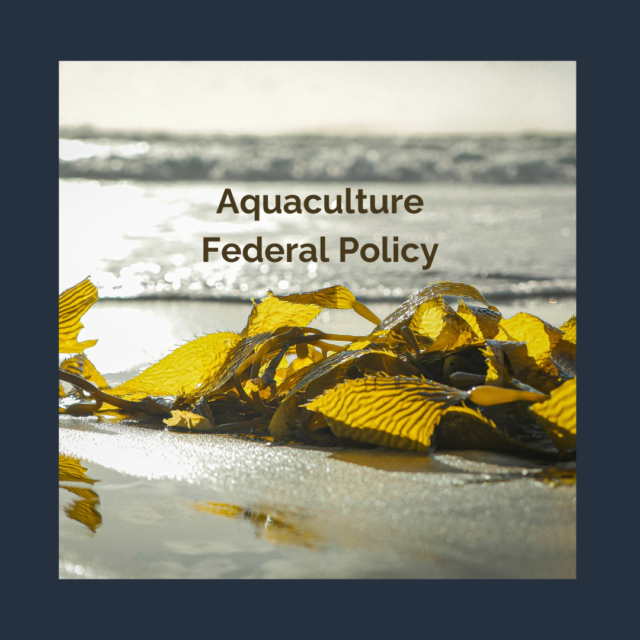 Aquaculture Policy Updates
Aquaculture Policy Updates
This year, federal representatives introduced (or re-introduced) a suite of federal policies addressing aquaculture industry needs, regulation and representation. The appetite for investing broadly in domestic seafood production through aquaculture is decidedly different this year, in the midst of a global downward-trending market for seafood products across the board.
The latest among those bills is the Science-based Equitable Aquaculture Food (SEAfood) Act, reintroduced in October by Reps. Nancy Mace (R-S.C.), Jimmy Panetta (D-Calif.) and Chellie Pingree (D-Maine).
The act would call for reports on permitting and scientifically sound regulatory requirements for domestic offshore aquaculture; authorize NOAA to create an assessment program that researches and implements offshore aquaculture projects; and create a NOAA grant program for minority-serving educational institutions to establish aquaculture education centers aimed at meeting the needs of a growing industry.
The Supporting Equity for Aquaculture and Seafood (SEAS) Act, introduced in August by Reps. Kat Cammack (R-Fla.) and Frank Pallone, Jr. (D-N.J.), proposes changes to federal agriculture policy to ensure that the USDA grant programs provide “fair funding levels” to aquaculture producers by giving them the same considerations as animal agriculture producers.
It would also direct USDA staff to draft two new reports for Congress – one on seafood and aquaculture expenditures and grants, and one on the USDA’s role in supporting aquaculture and the seafood industry. In addition, the bill would increase USDA funding for regional aquaculture centers to $30 million (up from roughly $5 million), add a USDA aquaculture education requirement for Farm Service Agency offices and instruct the department to develop a policy for aquaculture coverage under the Federal Crop Insurance Corporation.
Introduced during Capitol Hill Ocean Week in June, the Sustaining Healthy Ecosystems, Livelihoods, and Local Seafood (SHELLS) Act would create an Office of Aquaculture within the U.S. Department of Agriculture, including $25 million in funding, to promote shellfish, seaweed, and land-based aquaculture operations “that provide environmental, economic, and social benefits.”
Rep. Suzanne Bonamici (D-Ore.) said representation at the USDA “will help shellfish harvesters and seaweed farmers grow their small businesses while expanding blue carbon ecosystems that help address the climate crisis.”
The USDA Office of Aquaculture is designed to complement the NOAA Fisheries Office of Aquaculture, which issues permits for aquaculture operations in federal waters, helps implement federal aquaculture policies, and promotes domestic aquaculture development, most notably through its efforts to designate aquaculture opportunity areas.
The SHELLS Act was co-sponsored by Bonamici as well as Reps. Frank Pallone (D-N.J.), Rob Wittman (R-Va.) and Chellie Pingree (D-Maine).
Since its first round in 2018, the Advancing the Quality and Understanding of American Aquaculture (AQUAA) Act has been through various iterations on the Hill. This year’s reintroduction, courtesy of Sens. Roger Wicker (R-Miss.) and Brian Schatz (D-Hawaii) also introduced in June, has so far failed to overcome widespread and bipartisan opposition.
The bill, which is aimed at streamlining the regulatory and permitting process for aquaculture development, faces growing skepticism of the value-to-risk trade-offs of expanding investment in open-ocean finfish net pens, as well as the spread of corporate industrialization into marine spaces.
In March, Reps. Jared Huffman (D-Calif.) and Mary Peltola (D-Alaska) introduced the Coastal Seaweed Farm Act of 2023, which directs NOAA and the Department of Agriculture to evaluate and report on the benefits and effects of coastal seaweed farming. The two agencies should then use that data to develop regulations and establish evaluation metrics to ensure coastal seaweed farming, siting, and operations maximize potential benefits and avoid adverse impacts on the ecosystem, wildlife, fisheries, and local communities.
USDA’s National Aquaculture Census
Every five years, the U.S. Department of Agriculture conducts a national agriculture census. In 2005, the results of that census spurred the agency to follow up with a deeper dive on any respondents who noted in the census that they grow aquaculture products.
On Dec. 18, USDA’s National Agricultural Statistics Service will begin mailing copies of its 2023 Census of Aquaculture to those self-identified respondents. The service also provides an online portal at www.agcounts.usda.gov. Producers can use the portal to complete surveys and review historical reports. The deadline for responses is Jan. 15, 2024. NASS will release the data from the census on Dec. 16, 2024.
The goal of the Census of Aquaculture is to provide comprehensive domestic aquaculture data — including production volume and methods, surface water acres and sources, and sales — to be used by all levels of government, agribusinesses, trade associations, and producers.
NASS Administrator Hubert Hamer heralded the data-sharing as an opportunity for people to share their voices and showcase the uniqueness of American aquaculture. Nothing that it “will serve as the foundation for many decisions involving the sustainability and growth of the U.S. aquaculture sector for years to come.”
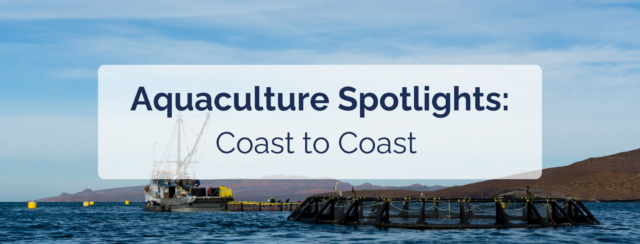
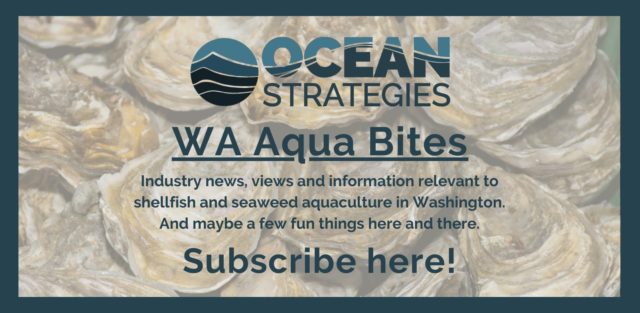 Ocean Strategies’ own WA Aqua Bites is a quarterly newsletter that informs the seafood supply chain of important aquaculture happenings in Washington State and beyond. The most recent edition includes:
Ocean Strategies’ own WA Aqua Bites is a quarterly newsletter that informs the seafood supply chain of important aquaculture happenings in Washington State and beyond. The most recent edition includes:
- Shellfish aquaculture opponents target “letters of permission” in Washington – Opponents of aquaculture are questioning the Army Corps use of letters of permission to permit shellfish farms in Washington State.
- Washington State’s net pen ban ruled to have no legal effect – Scroll for details.
West Coast
In November 2022, Washington state Public Lands Commissioner Hilary Franz declared a statewide ban on commercial fish-farm net pens.
The Jamestown S’Klallam Tribe and the Northwest Aquaculture Alliance filed a complaint against the Department of Natural Resources that resulted in an October 2023 ruling by Thurston County Superior Court Judge Indu Thomas describing the declaration as one step in the rulemaking process regarding commercial net pens in state jurisdiction.
Meaning, the state could continue that process, but it is not yet an illegal activity in the state.
Franz has since dropped out of Washington’s gubernatorial race (instead aiming for a Congressional seat),leaving Bob Ferguson and Mark Mullet as the top Democratic candidates; and Dave Reichert and Semi Bird contending for the Republican nomination.
Resources
- The Fish Site: Washington State’s fish farm ban ‘has no legal effect’
- Seafood Source: Jamestown S’Klallam Chairman W. Ron Allen vows to continue fight against Washington’s net-pen aquaculture ban\
Alaska
NOAA’s 2023 Alaska Aquaculture Accomplishments Report
NOAA’s Alaska Aquaculture Program released its 2023 Aquaculture Accomplishments Report in late September. This year, the program prioritized 10 of 17 national objectives listed in the agency’s five-year Aquaculture Strategic Plan.
This report highlights the 14 projects that supported the Alaska aquaculture priorities. Each of these diverse projects pursues the goal of promoting sustainable aquaculture growth in Alaska state waters.
Resource
- NOAA Fisheries: 2023 Alaska Aquaculture Accomplishments Report
New England
Massachusetts shellfish farmers harvested oysters and quahogs to the tune of nearly $37 million in dock value in 2022. In the commonwealth, shellfishing is regulated by individual cities and towns. But there has been growing debate in some Cape Cod communities about proposed changes to accessibility of those permits, which are now availableonly to residents.
The town of Barnstable, for example, is considering increasing the individual farm size limit from 4 to 14 acres, as well as a proposal to allow companies and corporate entities to hold licenses — not just town residents.
Resource
Gulf of Mexico
The Reef Fish Conservation and Education Foundation convened a group of conservation-minded Gulf of Mexico commercial fishermen and aquaculture stakeholders in hopes of forging a collaborative path.
“Initial results are incredibly promising,” said Eric Brazer, Deputy Director of the Gulf of Mexico Reef Fish Shareholders’ Alliance.
With critical support from Sea Pact, this working group met to share information, ask questions, and establish working relationships to tackle mutual threats and opportunities for our nation’s coastal communities, the U.S. seafood supply chain, and the American public’s access to domestic sustainable seafood.
Among the common themes the group aligned on is that working waterfronts are critical to the success and longevity of both industries.
Resource
Events & Opportunities
- December 18, 2023 – Deadline for comments on Alaska AOAs to NOAA Fisheries
- December 29, 2023 – Application deadline, Pacific Coast Shellfish Grower’s Association Executive Director job opening.
- January 15, 2024 – Deadline for responses to USDA Census of Aquaculture
- January 22, 2024 – Sea Grant-NCCOS California Aquaculture Siting & Development Workshop (virtual)
- February 18-21, 2024:
- Aquaculture America 2024 (San Antonio, TX)
- February 26-29, 2024:
- 3rd Annual Mariculture Conference of Alaska (Anchorage, AK)
- August 26-30, 2024:
- World Aquaculture 2024 (Copenhagen, Denmark)
